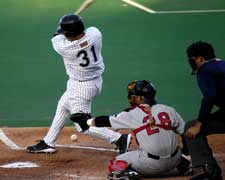
Offense: the batter (or "hitter")
Defense: the pitcher, catcher, and 7 others
 |
| The pitcher has just pitched the baseball toward his opponent, the batter. The umpire is partially blocking our view of the catcher, who is a team mate of the pitcher. |
In Overview, we described how each team alternates between offense and defense. Let's give the name Starter Team to the one that begins the game playing offense. Its nine players take turns trying to help their team score runs. There is a slight variation in one of the two leagues of Major League Baseball.
When it is his turn, each one takes his bat and stands in a designated area very close to home plate, on the right or left side, as he chooses. He is the current batter (or "hitter"). The order in which the nine players bat has to be preserved throughout the game.
Ender Team starts the game with its nine players on defense. One of them, the pitcher, has the specialty of throwing the baseball from a designated spot toward home plate and Starter Team's batter.
For now it is sufficient to say that the pitcher has incentives to throw the baseball over home plate without bouncing it.
 |
| Batter, catcher, umpire |
If the batter doesn't hit it, the catcher--who wears a mask and other protective equipment--catches the baseball and throws it back to his teammate, the pitcher, who tries again to throw the baseball past the batter.
The Other Players
 |
| Our old eyes see 9 defensive players, one of whom is close to the wall, top center. One umpire is in fair territory. Another may be chatting with a coach in foul territory. The batter (offense) has not appeared yet. |
While taking their turn playing defense, the rules allow seven of the defensive players ( to position themselves anywhere, as long as they're in fair territory. (The pitcher and catcher have special rules.) They usually spread themselves out in a way that is predictable: each one patrols an area, ready to catch any baseball that the opponent, the batter, manages to hit there. Some of the defensive players are feel responsible for defending a particular base, so they want to be near it. All defensive players, but especially these seven, are called fielders because they're spread across the playing field.
During any of the frequent pauses in the action, a team can send in a substitute for any of its current players, who cannot return to the game.
Don't get confused by the non-players
- Beginners may confuse baseball coaches with players because
they wear the same uniform.
While a team is playing offense, two of its coaches are allowed to stand in foul territory near first and third base, respectively. By words and signals they give orders and advice to the batter and any team mate(s) who may have been successful in arriving at a base. - Substitutes (and players) may be warming up, always in foul territory.
- Umpires, i.e. the referees. In the Major Leagues, there are usually four of them. They dress alike in gray, blue, or black suits or sportswear.



